Orient
Line RMS Ormuz 1886 to 1912 - SS Divona 1912 to 1922
Please Note:
Firefox or Google Chrome
may not be suitable - Please use Internet Explorer
for this page to load perfectly!
Click the logo above to reach the ssMaritime FrontPage
for News Updates & “Ship of the Month”
With Reuben Goossens
Maritime Historian, Cruise‘n’Ship
Reviewer & Author
Please Note: All ssMaritime
and other related maritime/cruise sites are 100% non-commercial and privately
owned. Be assured that I am NOT associated with any shipping or cruise
companies or any travel/cruise agencies or any other organisations! Although
the author has been in the passenger shipping industry since 1960, although is
now retired but having completed over 690 Classic Liners and Cargo-Passengers Ships features I
trust these will continue to provide classic ship enthusiasts the information the
are seeking, but above all a great deal of pleasure!

Page Two
The R.M.S. Ormuz I
My Thoughts on Travel Today & in the
late 1800s:
In these the modern days, it simply takes just
a day to travel from
One of the exciting new ships completed in
1886 was the RMS Ormuz, built
in the
Her beginnings:
In 1883 The Orient Steam Navigation Co. Ltd.,
of
Five years later, in 1888, Orient Line had not only taken delivery of their new liner the RMS Ormuz, but she had already made the News, as it was reported in a London Periodical that the Orient lines Ormuz had landed a consignment from South Australia consisting of apples, pears, grapes, oranges, quinces, lemons, melons and pomegranates.” And then they made it very clear that all this must have come over on the Ormuz’s “cold storage, otherwise it would not have arrived as fresh as it did, considering it having sailed through hot and tropical waters!
Note: RMS means Royal Mail Service!
RMS Ormuz (I):
Having been carefully planned and using one of the company’s finest interior designers, such as J. J. Stevenson F.R.I.B.A., who had already worked on a number of earlier ships and would now place his stamp on the Ormuz! Thus an order was placed for her to be built at Fairfield Shipbuilding and Engineering Co. Ltd., Glasgow, where her hull was laid down in Yard 317.
The new almost completed liner was officially
launched on September 29, 1886 and after her fit-out and trials were completed,
on December 29, 1886 she was registered at
The 6,031 GRT (Gross Registered Ton) RMS Ormuz was 464.5ft - 141.55m long and she and she accommodated 106 passengers in a well fitted out and comfortable First Class, and 170 in a well appointed Second Class. In addition there a more humble migrant accommodations in Third Class, which was also known as steerage, which carried 120 passengers. Third Class offered both male and female dormitories for assisted emigrants, as well as some smaller cabins for ladies with babies and young children. In addition there were 8 and 6 berth and a few 4 berth cabins for Third Class fare paying passengers. Thus the Ormuz carried a total of 396 passengers!
When it came to cargo she carried general
cargoes in her five holds, but she did have 44,501 cubic feet of cooled cargo
space to transport lamb, butter, and fruit from
The RMS Ormuz departed on her maiden voyage
from
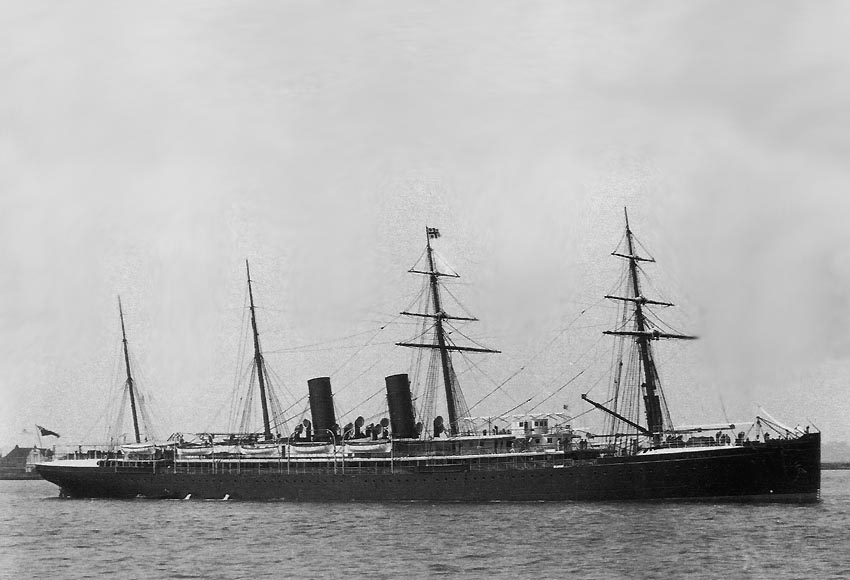
Here
we see the Ormuz whilst she is still on her maiden voyage and her Promenade
deckhouse has not been painted white as yet
Having arrived again in
The truth is that Orient Line was so proud of the Ormuz, that they had mounted an inscription above the entrance to the First Class Saloon that read:
--“Were the World a Ring of Gold, Ormuz would be
its Diamond.”--
As I mentioned above, she made the news upon
her return to
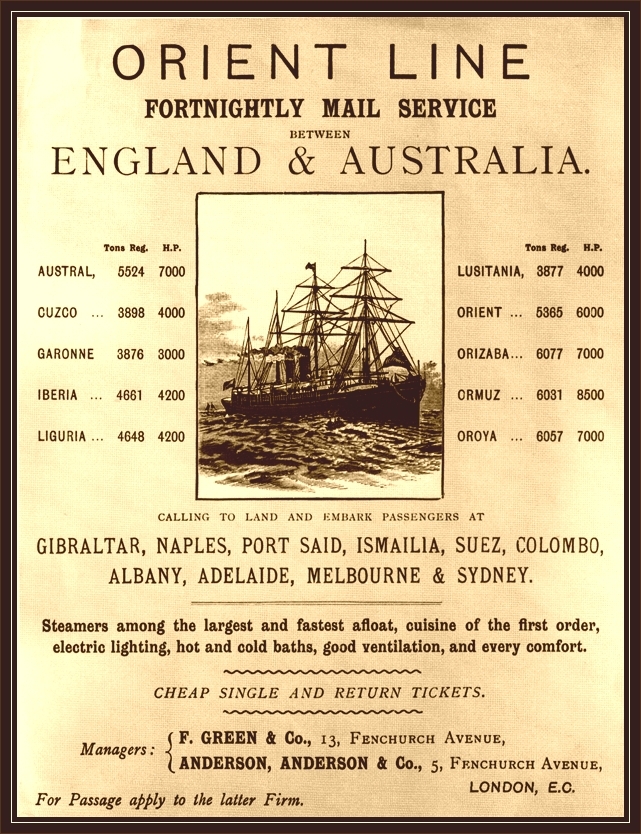
As
we can see, the Orient Steam Navigation Company had been busy promoting their
ships on posters
The
RMS Ormuz is on the right hand column, the fourth down
Images of her Interiors
Obviously, photographs of the ship’s exterior are available, and I have some of these on this page, but her interiors are confined to sepia line drawings, which I present below. On Page Two, I have her Deck Plan, but it only contains First and Second Class and sadly I have not been able to locate her Third Class Plan as it seems to be missing it altogether. However, I have noted that there were three stairwells heading down to C Deck to, I assume the Third Class accommodations. I do know that it was not unusual in those days that bunks were stacked three high! I have these stairwells clearly marked by the means of an enlarged insert! Please Note: The Ormuz Deck Plan is on Page Two - Use the link at bottom of this page.
First Class
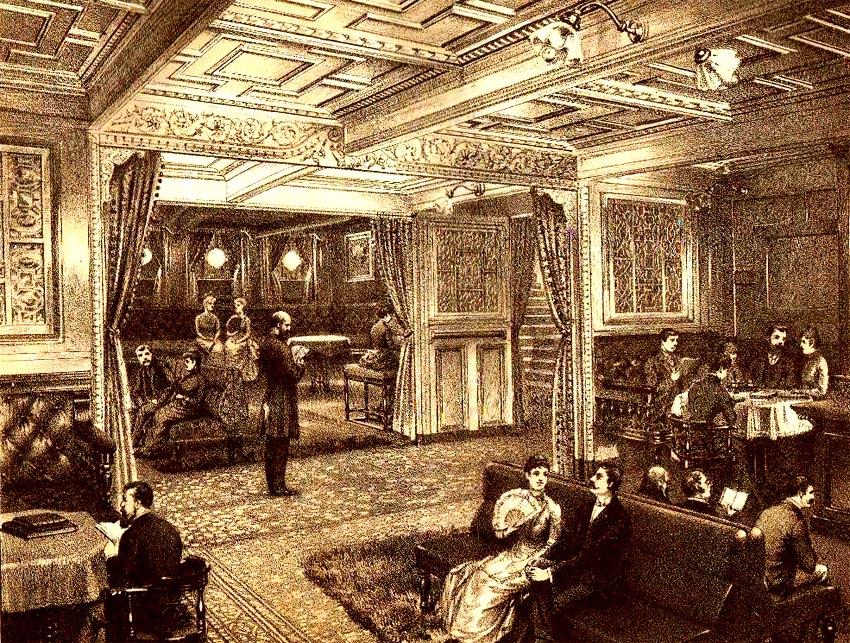
The
delightful Drawing Room and Library was located just ahead of the A Deck Lobby
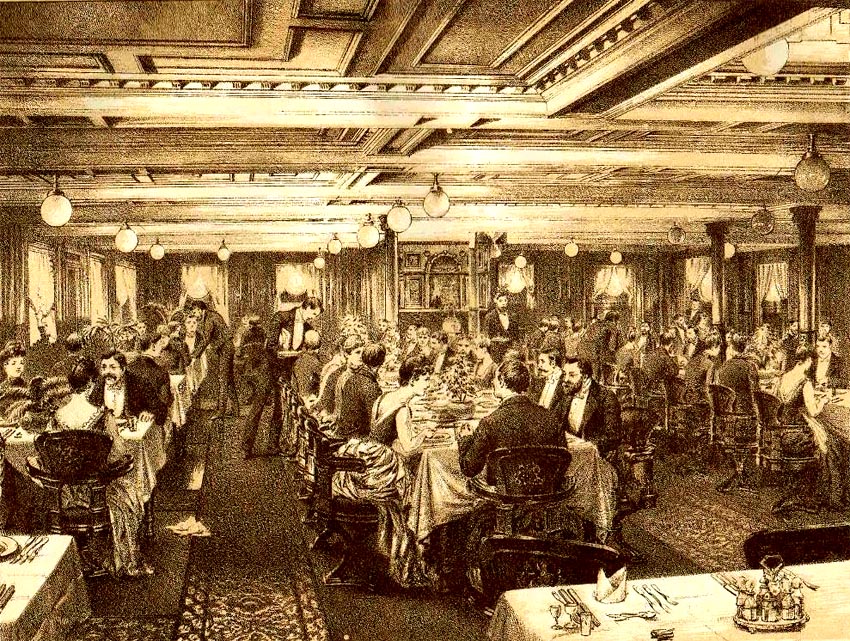
The
elegant and spacious Dining Saloon was located forward on Promenade Deck
Just
forward of this venue were the Smoking Room and the Deck Saloon
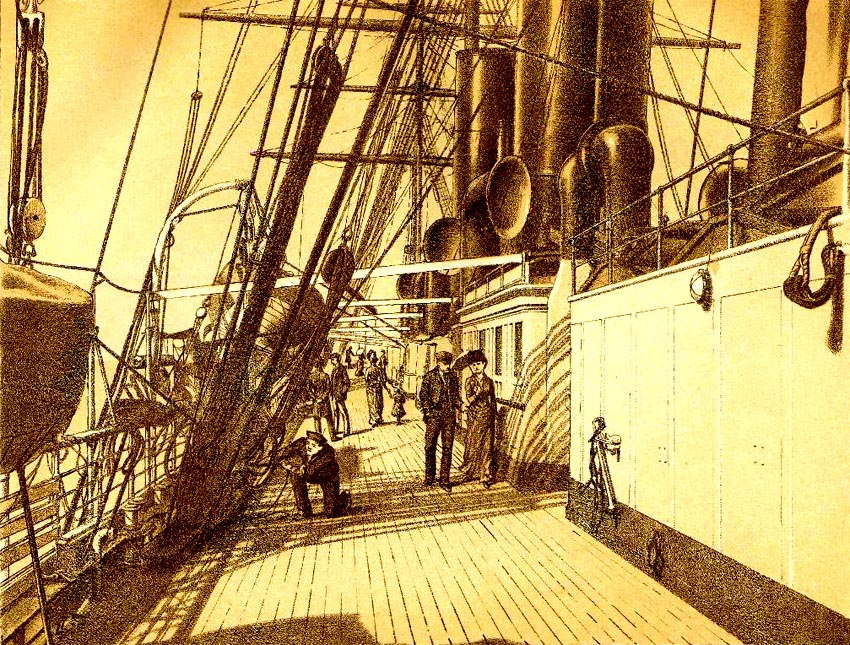
Although
the First Class part of the deck ended where the two passengers stood, and a
gate
would
separate it from the Second Class deck space, as there were 2nd.class cabins located there
Second Class
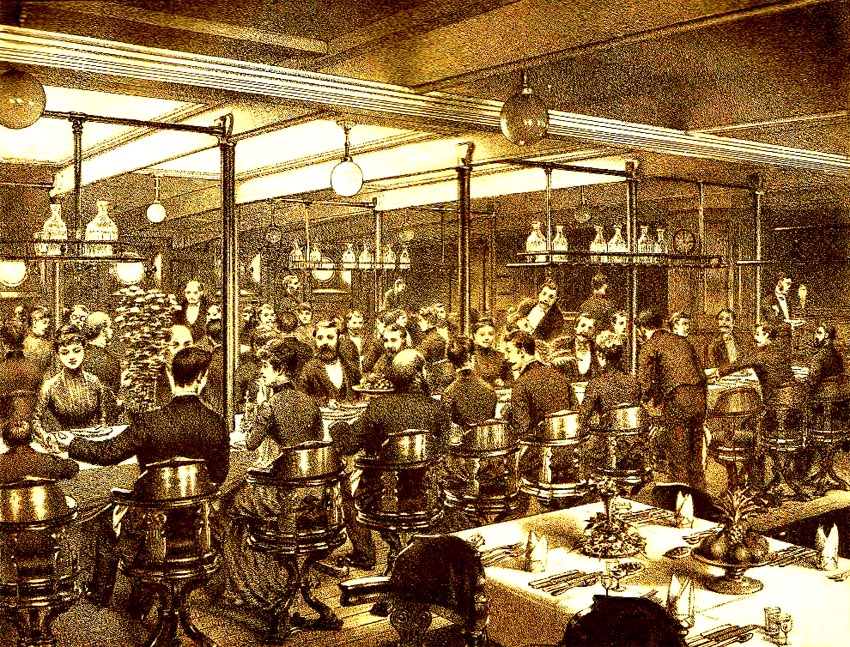
The
Second Class Dining Saloon was also spacious and was of a high standard
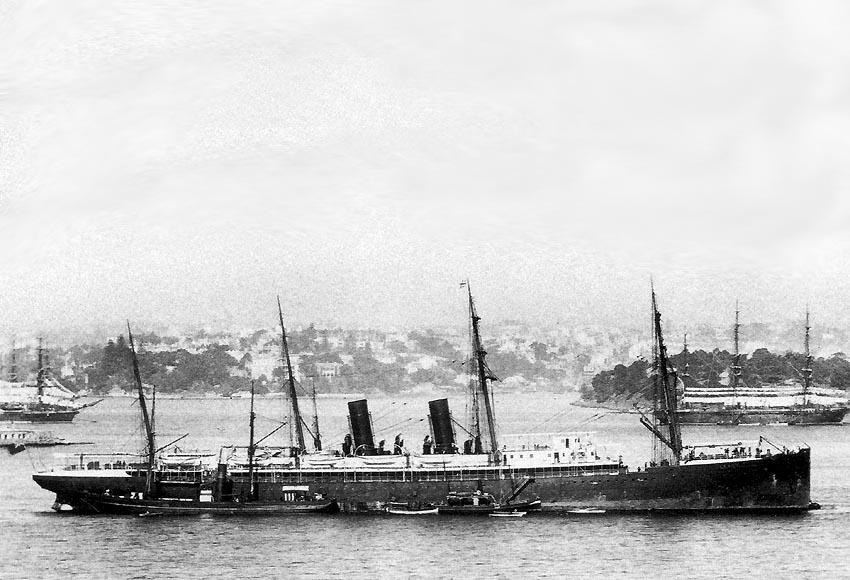
The
RMS Ormuz is seen arriving in
white
superstructure and her masts altered, as she would mostly sail by steam
R.M.S. Voyages:
Below is just one of the R.M.S. Ormuz’s
voyages that I have been able to obtain, as the following was listed in the
“Shipping News” of the “London Times” as follows:
Feb 2: “S.S. ORMUZ embarked passengers and 41
sacks of long-sea-route mails at Plymouth on Saturday and proceeded at 4 p.m.
for Gibraltar, Naples, Colombo, and Australia.”
Feb 4, 1891: “The Orient Line s.s.
ORIENT, from
passed Guia at 9 a.m. yesterday.”
Feb 5: “The ORMUZ, from
Feb 10: “The ORMUZ, from
Feb 13: “The ORMUZ, from
Feb 16: “The ORMUZ, from
Feb 18: "The ORMUZ, from
Feb 24: “The ORMUZ, from
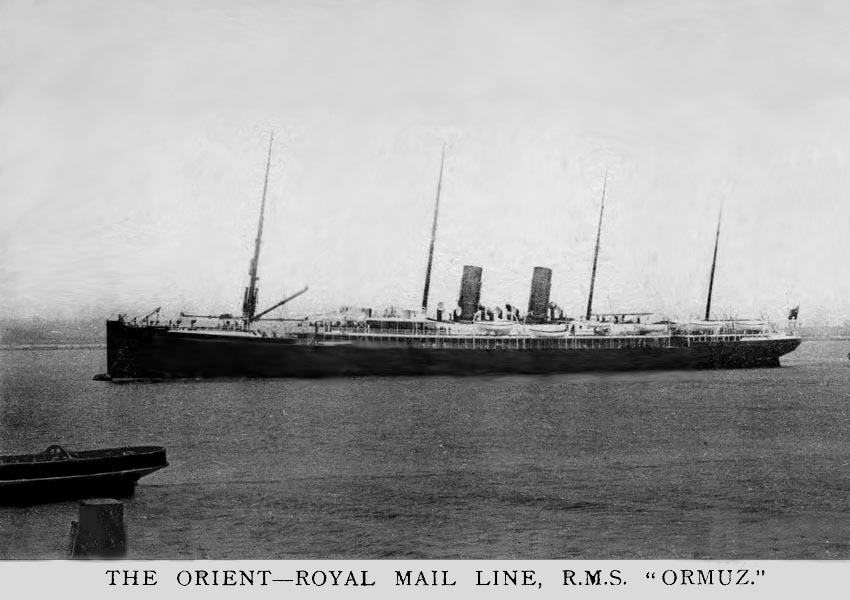
A
postcard sold on board
Feb 25:
“The ORMUZ, from
March
12: “The Orient Line S.S. ORMUZ, from
March
17, 1881: “The Orient Line S.S. ORMUZ, from
There is no details regarding her return
voyage, however there is a photographic record of the RMS Ormuz departing
Sydney when she had offloaded her passengers, cargoes, and then taken on cargo
and last, but not least new passengers for the voyage home. She usually
remained in
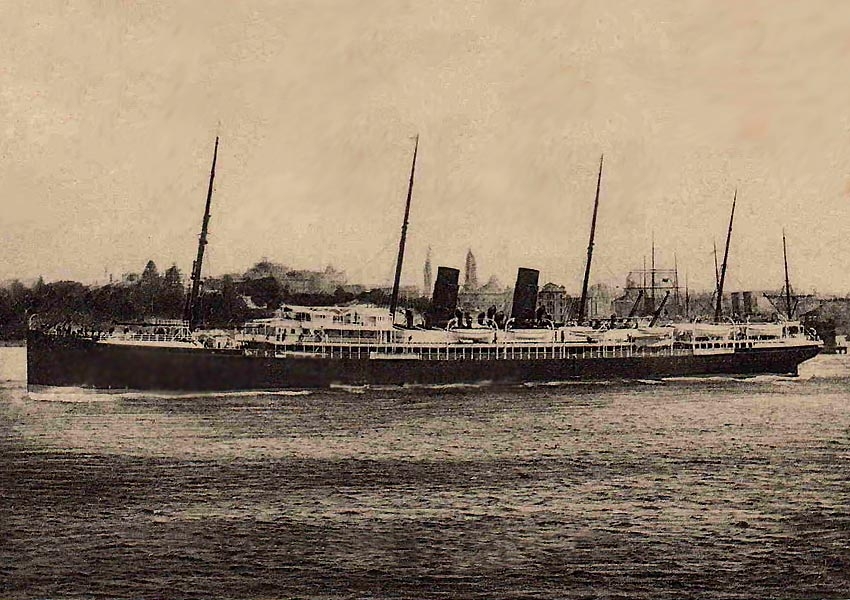
The
Ormuz is seen departing
The Sad Night of December 11, 1900:
Although the RMS Ormuz made many voyages to
and from
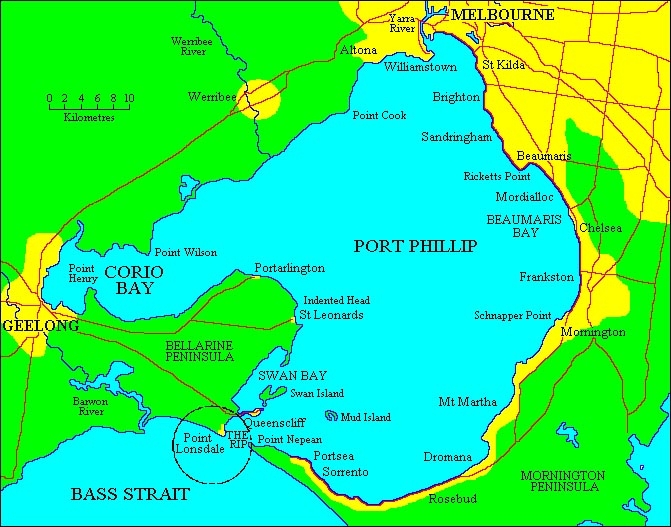
Note:
Both the Rip and Point Lonsdale lighthouse is highlighted,
to
be treacherous and the Rip is narrow and it takes a good pilot to navigate a
passenger liner through it
COLLISON IN THE RIP.
“Queenscliff, Tuesday Night. At 9 o’clock this evening the light keeper at Point Lonsdale reported a collision in the rip between the supposed outward bound R.M.S. Ormuz and an incoming steamer, supposed to be the Ismalia. The weather was fine, with a clear sky, and the sea was smooth, while a strong ebb tide was prevailing. After colliding the steamers hung together for about five minutes and the shouts from those on board could be distinctly heard from the shore.
Both steamers remained stationary near each other until 11 o’clock, when the incoming steamer proceeded slowly up the south channel, after which the Ormuz went on with her voyage. No signals of distress were shown by either vessel.
Wednesday Morning.
At 1 a.m. the supposed R.M.S. Ormuz which had
collided with another steamer four hours previously in the Rip, re-entered the
Heads, and under easy steam returned to
Blame and Repairs:
There was a lengthy court case, but on Wednesday February 9, 1901, the court blamed and suspended the Pilot, Captain Emerson with the charge of miss-conduct for he apparently did not navigate according to Maritime article 21, causing the collision. His licence was suspended for 12 months and he was ordered to pay a very hefty sum of £100 and that would be that would be a good £10,888.81 today.
The Ormuz finally departed
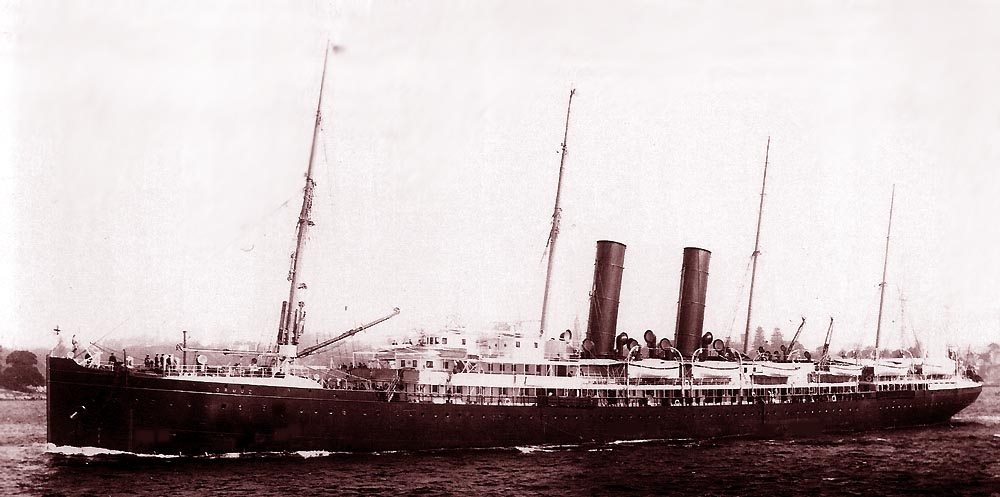
The
RMS Ormuz is seen departing
The R.M.S. Ormuz may not have been the most remarkable ships ever built, however she certainly was a good and a faithful ship that caused the company no problems, with her engines working perfectly, as it was well maintained, as was the rest of the ship! In thirty two Years she has made seventy Royal Mail Voyages to Australia and back and the Orient Line had decided to sell the Ormuz, as the had on order new and improved ships, with greater capacities and far more modern than her. Thus in 1912 she was sold to a French Shipping Company.
Two Fine Artistic Postcards of the R.M.S.
Ormuz:
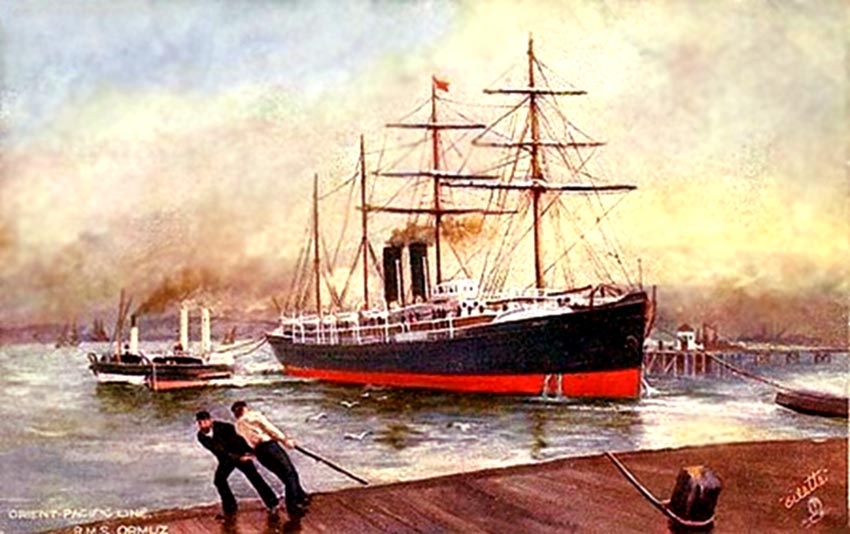
Above
& below: Here are two very special artistic postcards
one of the RMS Ormuz early days (above) and the other from her latter days!

SS Divona, ex RMS
Ormuz:
It was on April 10, 1912 that the Orient Line
sold the Ormuz to Compagnie de Navigation Sud Atlantique, of
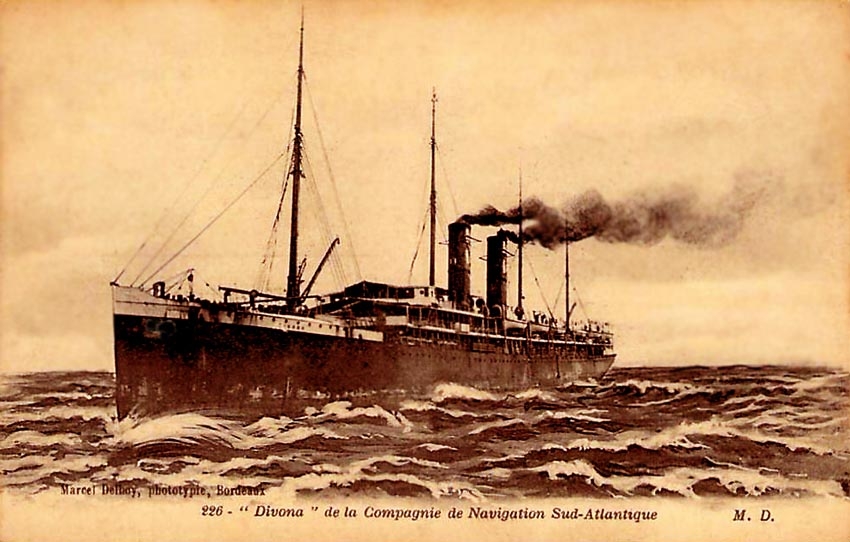
A
Postcard of the SS Divona released by Compagnie de
Navigation Sud Atlantique
in 1912
However, on December 5, 1915 the SS Divona was requisitioned by the French Government and she
was converted at
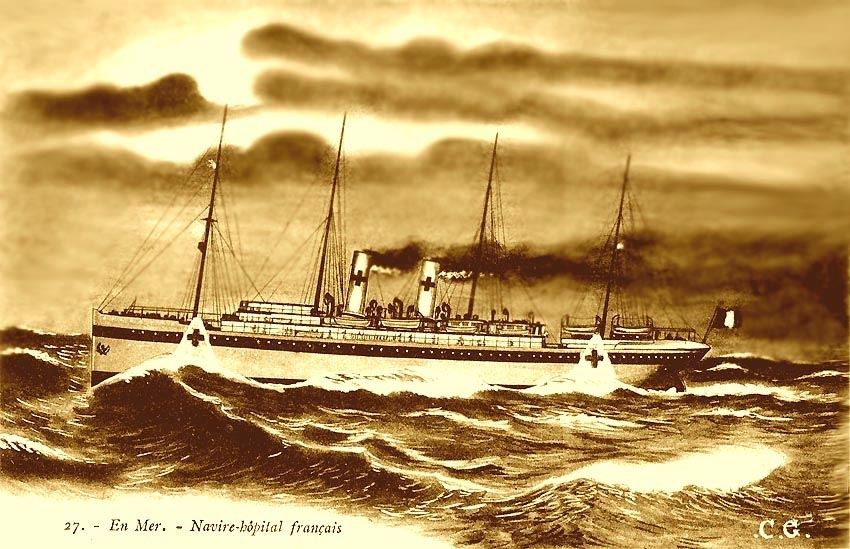
Here
we see the Divona
The on April 1, 1918 she was returned to her owners, however, no sooner they were going to refit her, the French Government again requisitioned her, bit this time to operate as a for troop ship.
Two years later, in March 1920 she was again returned to her owners, however, considering the ship was now 34 years old, and for those days that was considered at least 4 years after retirement days, as well as her having gone through the war and having taken on beating from her duties as a Hospital and a Troop ship for the last 4+ years, the cost of refitting her would be far to costly and thus she was laid up and placed on the market. However, because she was an old style ship, there were no buyers for her and thus it was decided in due course to sell her to be broken up.
The ex RMS Ormuz, SS Divona departed Bordeaux under tow in June 1922, and she arrived on June 11 at Marseilles to be demolished, which was completed later in that year.
RMS Ormuz Specifications:
Built
by:
Yard: 317.
Launched: September 9, 1886.
Maiden
Voyage: February 3,
1887.
Tonnage: 6,031 GRT
– 2,940 NET.
Length: 464.5ft -
141.55m.
Breadth: 52.1ft -
15.87m.
Draught: 34.1ft -
10.38m.
Power: 2x 3 Cylinder
engines, 1,400 MHP, 9,000 IHP.
Propellers: Two.
Speed: 15.5 knots,
18. knots Maximum.
Passengers: 106 First, 170
Second and 120 Third Class (Steerage).
Passenger
Decks: 3.
Cargo: 5 Holds , which included *cooled
cargo.
Other
Names: April 10,
1912 SS Divona - Late 1922 she was broken up.
*In addition to her considerable cargo space, she had that amazing
44,501 cubic feet of cooled cargo space, which was to transport, as we read
earlier various fruits and other food items, especially lamb butter and other
goods back from
Remembering
the Early Days of the Emigrants Coming to
On an
Orient Liner the … R.M.S. Ormuz (I)
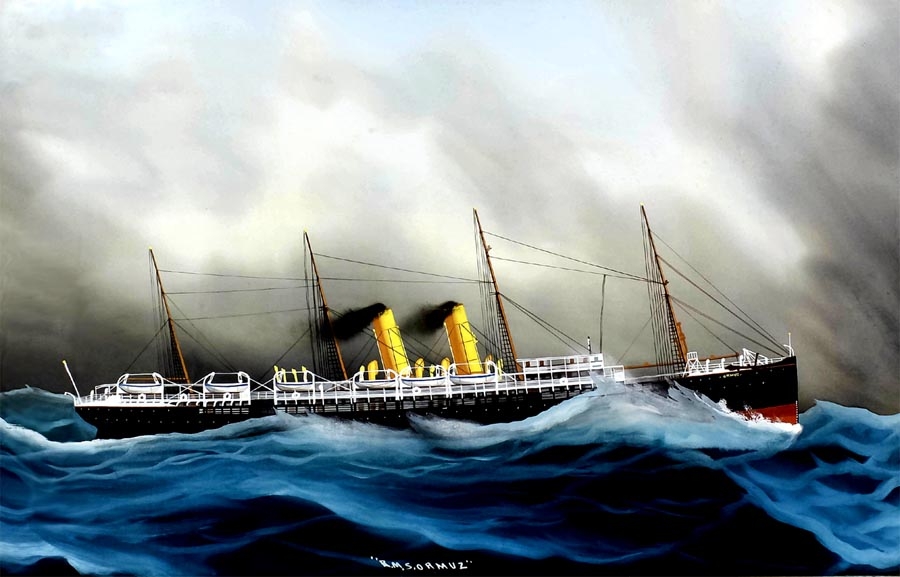
The
RMS Ormuz on a Stormy
Sadly the
painter of this superb work is unknown- See the photo notes at the bottom of
the page!
RMS Ormone (1) & Ormonde (2) Index:
Page
One … RMS Ormuz (1) History page.
Page
Two … RMS
Ormuz (I)
Deck Plan.
Page
Three … RMS Ormuz (2) History page.
“Blue Water Liners sailing to the
distant shores.
I watched them come, I watched them go and I watched them die.”
****************************
Return to the
ssMaritime Main INDEX
Where you will discover well over 750 Classic
Passenger & Passenger-Cargo Liners!
ssMaritime.com & ssMaritime.net
Where the ships of the past make history & the 1914 built MV Doulos Story
Please
Note: ssmaritime and associated sites are 100% non-commercial
and the author seeks no funding or favours of any shape or form, never have and
never will!
Photographs on ssmaritime and associate pages are by
the author or from the author’s private collection. In addition there are
some images that have been provided by Shipping Companies and private
photographers or collectors. Credit is given to all contributors. However,
there are some photographs provided to me without details regarding the
photographer/owner concerned. I hereby invite if owners of these images would
be so kind to make them-selves known to me (my email address may be found on www.ssmaritime.com only), in order that due credit may be
given.
This notice covers all pages, although, and I have
done my best to ensure that all photographs are duly credited and that this
notice is displaced on each page, that is, when a page is updated!
ssMaritime is owned
& © Copyright by Reuben Goossens - All Rights Reserved
